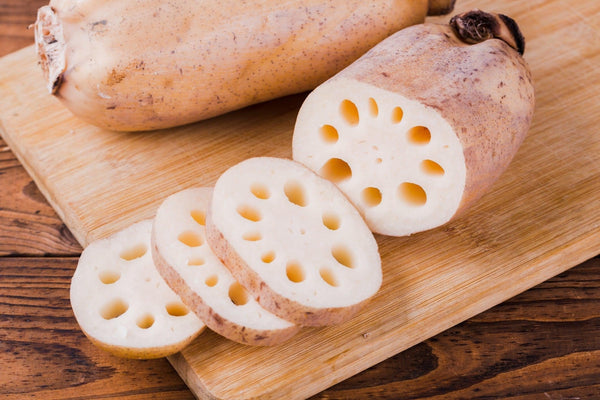
Jump to:
Have you noticed a sliced root vegetable that commonly appears in Tempura and pot-based Japanese dishes that resembles a wagon wheel? You are looking at lotus root (Renkon in Japanese), which is the edible stem of the lotus flower, the perennial aquatic plant known for its distinct shape and beautiful white and pink flowers. Lotus root is a versatile vegetable (see here for an introduction to Japanese vegetables), a mainstay of Japanese cuisine, and a great source of nutrition.
In this blog post, we shall examine the characteristics of the lotus root, its history, possible health benefits, how it is used in Japanese cooking including some recipes for using it, where to buy it, how to choose a good lotus root, and tips for storing it.
Features Of The Lotus Root

Did you know that there is a fixed number of pea-sized holes in lotus root? When sliced, it has a lace-like design with ten holes – one in the middle and nine around the perimeter. The taste of lotus root is mildly sweet and is similar in many ways to water chestnut. It has a crisp starchy, crunchy texture, which is similar to celery when raw. This softens when cooked, but it is still retained to a certain extent.
History Of Lotus Root Use In Japan
The Joriku Fudoki ancient records, in 713, mention that lotus root was consumed in the area that is now Ibaraki Prefecture. After the Kamakura period (1185-1333), a variety introduced from China by the monk Dogen and others spread to various regions, becoming the current native species.
In terms of the start of widespread consumption, it is said that Tadatoshi Hosokawa, the lord of the Kumamoto domain in the 17th Century, was sickly and was advised by a Zen monk to eat lotus root. A vassal then noticed the lotus root that Kiyomasa Kato had grown as an emergency ration near the outer moat of Kumamoto Castle, and this was presented it to Tadatoshi by stuffing the holes with barley miso mixed with Japanese hot pepper powder, battering it with barley flour, fava bean flour, and egg yolk, and deep frying it. This was probably the first rendition of the popular dish Karashi-Daikon that is described later in this article.
Lotus roots then expanded in culinary use after Chinese Lotus species were carried to Japan in the Meiji period, from 1868 to 1912, and it has become a mainstay of Japanese cuisine since then.
Is Lotus Root Good For You?
Similar to fruits like Nasu (Japanese eggplant), lotus root has a very high water content, and for this reason, people tend to think of it as a nutrition-free vegetable. This, however, couldn’t be further from the truth. For a start, it contains a rich array of vitamins and minerals.
Lotus root not only has 1.5 times the amount of vitamin C found in oranges, but the starch in lotus root protects vitamin C from heat, which means its benefits are largely maintained even when it is cooked. Vitamin C has a strong antioxidant effect, and thus promises to be effective in relieving fatigue, bolstering the immune system, preventing diseases such as arteriosclerosis and cancer, and strengthening skin and bones.
Lotus root has dietary fiber to prevent constipation. It contains both water-soluble and water-insoluble fiber. It includes pectin, a water-soluble fiber, which is said to prevent high blood pressure. The water-insoluble fiber absorbs water to increase stool volume and facilitate defecation.
It also includes potassium and tannin. Potassium excretes sodium in the urine and is said to be effective in regulating excessive salt intake and preventing hypertension. Tannin has hemostatic and anti-inflammatory effects and may be effective against gastric ulcers and duodenal ulcers.
Buying And Choosing Lotus Root

Lotus root can be purchased in the vast majority of greengrocers and supermarkets in Japan in whole form or cut in half and is also available in canned form. When choosing lotus root, the shape should be chunky and round, and the skin should be flawless and dimpled. Fresh roots should feel heavy and firm in the hand. When sold in cut form, pay attention to the cut end. If the surface or the inside of the holes is dark, this is a sign that it has aged and has become stained.
If you would like to enjoy the health benefits of lotus root but are not sure how to include it in your food, or if you are looking for a snack, you might like to try these different varieties of lotus root chips. If you are feeling really adventurous, you can also make your own lotus root chips at home!
Preparing Lotus Root

Lotus root adds a floral appearance when sliced into rounds and a crisp crunchy texture to dishes. In fact, it is said that the flavor of the lotus root varies depending on the way you prepare it. Although lotus root can essentially be eaten with the skin on, the skin is rather tough and not very crispy. Peeling the skin gives it a softer, more colorful appearance and makes it easier for the flavors of other foods to penetrate. It is recommended to hold the lotus root in one hand and peel it using a vegetable peeler.
The texture of lotus root depends on the direction in which it is cut. Cutting thick vertical slices along the fibers gives a crispy texture. However, if you cut them into thicker rings, the texture will be softer. Not only the orientation of the fibers, but also the thickness in which they are cut, and the cooking time will change the texture.
Lotus root can be cut in the following ways:
- Thickly cut into half-moon shapes – The lotus root keeps its original texture, and this is often used for dishes like Kinpira, Tempura, and sauteed dishes.
- Vertically sliced – The lotus root stays very crunchy, and this is good for stir-fried and simmered dishes.
- Thinly sliced – The lotus root becomes very crispy, and this is often the way it is prepared for vinegar-based dishes and salads.
After being cut, the color of the lotus root tends to become brown very quickly, so it should be immediately soaked in water to remove the bitter taste of the starch and avoid exposure to the air.
Tips For Storing Lotus Root
If the lotus root is to be eaten immediately, it can be stored in the refrigerator. Wrap the lotus root in a paper towel and store it in a plastic bag in the vegetable compartment of the refrigerator. When stored whole, it can be stored for about one week. When the lotus root has already been cut, you can wrap the cut side with plastic wrap and store it for about three days.
If the lotus root still has mud attached, you can keep it fresh longer by wrapping it in damp newspaper or cooking paper without removing the mud, placing it in a storage bag or plastic bag, and storing it in a cool place out of direct sunlight.
Popular Japanese Dishes Containing Lotus Root
One particularly interesting aspect of Japanese cuisine is the versatile way in which it uses various root vegetables. Below, we have outlined some popular Japanese dishes containing lotus root.
Tempura

Tempura is one of the most famous types of Japanese food, in which seafood and vegetables are lightly coated in batter and deep-fried. One of the most commonly used vegetables in Tempura is sliced lotus root, and this can be enjoyed dipped in Shoyu (Japanese soy sauce) or Ponzu sauce with grated daikon.
Karashi-Renkon

This is a traditional dish from Kumamoto Prefecture in Kyushu, in which the holes of the lotus root are stuffed with karashi (Japanese mustard) miso before being deep fried. As mentioned, this dish was originally prepared as a tonic for Kumamoto feudal lord Tadatoshi Hosokawa. The lure of this dish is the exquisite aromatic blend of the Japanese mustard and miso, as well as the texture of the deep-fried lotus root.
Chikuzen-Ni

Chikuzen-ni is is a local dish of the Chikuzen region in the northern and western parts of Fukuoka Prefecture. It consists of a stew of chicken, vegetables, konnyaku and the like, stir-fried in oil and seasoned with sweet and spicy sauce. Lotus root is a prominently used root vegetable in Chikuzen-ni.
Kinpira-Renkon

The term “Kinpira” refers to a Japanese cooking technique that might best be described as “saute and simmer”. This is often used to cook root vegetables, including Gobo (burdock root), carrots, and, in this case, lotus root. The lotus root is first stir-fried and then simmered in seasonings such as Shoyu and Mirin. Red chili peppers may be added at the end to give it an extra spicy punch.
A Root Vegetable Worth Getting To Know
At first glance, the lotus root may look somewhat chunky and unwieldy, and you might hesitate to try to use it in your own cooking. However, lotus root is a root vegetable that you will encounter many times in Japanese cuisine. Not only does it have a very pleasant, sweet taste and a crisp, chunky texture, but aesthetically, its floral design when thinly cut can greatly improve the presentation of your meals. Lotus root is also kind to your body, providing a wide range of vitamins and minerals, particularly vitamin C, as well as being a rich source of both water-soluble and water-insoluble dietary fiber.
What is your favorite way of enjoying lotus root? Let us know in the comments.


0 comments